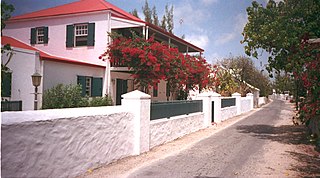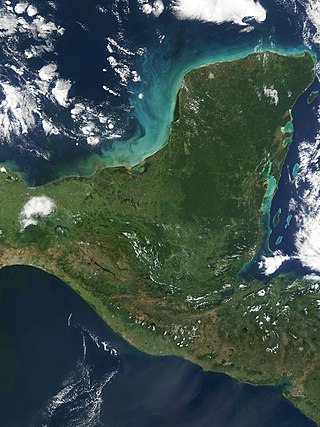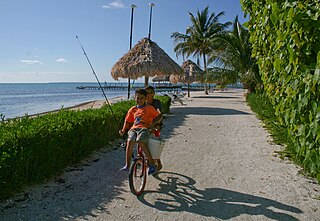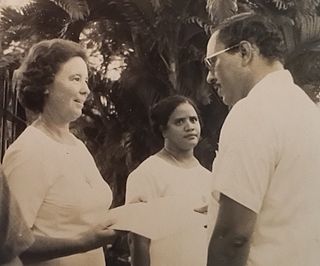 | |
| Established | 2002 |
|---|---|
| Location | Belize City, Belize |
| Type | History museum |
The Museum of Belize is an art and history museum in Belize City, Belize.
 | |
| Established | 2002 |
|---|---|
| Location | Belize City, Belize |
| Type | History museum |
The Museum of Belize is an art and history museum in Belize City, Belize.
Built between 1854 and 1857 [1] as a Her Majesty’s Prison while the area was still a British colony, it was a replacement for a wooden prison nearby. It was the Belize City Prison until 1993, when prisoners were then transferred to the Hattieville Prison [2]
In 2002, it was restored and renovated into a national museum.
It features exhibits on slavery in Belize including a timeline, information about slave revolts and communities of escaped slaves (maroons), Maya artifacts and explores some 3,000 years of Maya history, the prison's history, colonial life, natural history, visual arts, and cultural exhibits of the many ethnic groups of the nation. [3]

Belize is a country on the north-eastern coast of Central America. It is bordered by Mexico to the north, the Caribbean Sea to the east, and Guatemala to the west and south. It also shares a water boundary with Honduras to the southeast. It has an area of 22,970 square kilometres (8,867 sq mi) and a population of 441,471 (2022). Its mainland is about 290 km (180 mi) long and 110 km (68 mi) wide. It is the least populated and least densely populated country in Central America. Its population growth rate of 1.87% per year is the second-highest in the region and one of the highest in the Western Hemisphere. Its capital is Belmopan, and its largest city is the namesake city of Belize City. Belize is often thought of as a Caribbean country in Central America because it has a history similar to that of English-speaking Caribbean nations. Belize's institutions and official language reflect its history as a British colony.

Belmopan is the capital city of Belize. Its population in 2010 was 16,451. In addition to being the smallest capital city in the continental Americas by population, Belmopan is the third-largest settlement in Belize, behind Belize City and San Ignacio. Founded as a planned community in 1970, Belmopan is one of the newest national capital cities in the world. Since 2000, Belmopan has been one of two settlements in Belize to hold official city status, along with Belize City.

Belize City is the largest city in Belize. It was once the capital of the former British Honduras. According to the 2010 census, Belize City has a population of 61,461 people. It is at the mouth of the Haulover Creek, which is a distributary of the Belize River. The Belize River empties into the Caribbean Sea eight kilometres from Belize City on the Philip Goldson Highway on the coast of the Caribbean. The city is the country's principal port and its financial and industrial hub. Cruise ships drop anchor outside the port and are tendered by local citizens. The city was almost entirely destroyed in October 1961 when Hurricane Hattie swept ashore. It was the capital of British Honduras until the government was moved to the new capital of Belmopan in 1970.

British Honduras was a Crown colony on the east coast of Central America, south of Mexico, from 1783 to 1964, then a self-governing colony, renamed Belize in June 1973, until September 1981, when it gained full independence as Belize. British Honduras was the last continental possession of the United Kingdom in the Americas.

The Caste War of Yucatán or ba'atabil kichkelem Yúum (1847–1915) began with the revolt of native Maya people of the Yucatán Peninsula against Hispanic populations, called Yucatecos. The latter had long held political and economic control of the region. A lengthy war ensued between the Yucateco forces based in the northwest of the Yucatán and the independent Maya in the southeast.

The Maya are an ethnolinguistic group of indigenous peoples of Mesoamerica. The ancient Maya civilization was formed by members of this group, and today's Maya are generally descended from people who lived within that historical region. Today they inhabit southern Mexico, Guatemala, Belize, El Salvador, Nicaragua, and Honduras. "Maya" is a modern collective term for the peoples of the region; however, the term was not historically used by the indigenous populations themselves. There was no common sense of identity or political unity among the distinct populations, societies and ethnic groups because they each had their own particular traditions, cultures and historical identity.

Cockburn Town is the capital of the Turks and Caicos Islands, spreading across most of Grand Turk Island. It was founded in 1681 by salt collectors.

The Yucatán Peninsula is a large peninsula in southeast Mexico and adjacent portions of Belize and Guatemala. The peninsula extends towards the northeast, separating the Gulf of Mexico to the north and west of the peninsula from the Caribbean Sea to the east. The Yucatán Channel, between the northeastern corner of the peninsula and Cuba, connects the two bodies of water.

His Majesty's Prisons is the name given to prisons in the United Kingdom, as well as some in Australia and a small number in Canada, Grenada, Jersey, The Bahamas and Barbados. The title makes up part of the name of individual prisons and is usually abbreviated to HM Prison or HMP.

Ucanal is an archaeological site of the ancient Maya civilization. It is located near the source of the Belize River in the Petén department of present-day northern Guatemala.

The monarchy of Belize is a system of government in which a hereditary monarch is the sovereign and head of state of Belize. The current Belizean monarch and head of state since 8 September 2022, is King Charles III. As sovereign, he is the personal embodiment of the Belizean Crown. Although the person of the sovereign is shared with 14 other independent countries within the Commonwealth of Nations, each country's monarchy is separate and legally distinct. As a result, the current monarch is officially titled Kingof Belize and, in this capacity, he and other members of the royal family undertake public and private functions as representatives of the Belizean state. However, the King is the only member of the royal family with any constitutional role.

The history of Belize dates back thousands of years. The Maya civilization spread into the area of Belize between 1500 BC to 1200 BC and flourished until about 1000 AD. Several Maya ruin sites, including Cahal Pech, Caracol, Lamanai, Lubaantun, Altun Ha, and Xunantunich reflect the advanced civilization and much denser population of that period. The first recorded European incursions in the region were made by Spanish conquistadors and missionaries in the 16th century. One attraction of the area was the availability of logwood, which also brought British settlers.

Belizeans are people associated with the country of Belize through citizenship or descent. Belize is a multiethnic country with residents of Ethnic groups of Amerindian, African, European, Asian and Middle-eastern descent or mixed race with any combination of those groups.
The Belmopan Museum is a long-planned national museum in Belmopan, the capital of Belize. The originally planned building was to be an ambitious state-of-the-art center for displaying information about the environment and society of Belize, including an exhibit of Mayan archaeology. The project was cancelled, but recently there have been plans to revive it. The Institute of Archaeology's library and collection of Mayan artifacts has been sporadically open to the public in the Archaeology Museum and Research Centre, Belmopan since the late 1990s.
Heather Hurst is an American archaeologist and archaeological illustrator.

Grace Bank, formerly Barcadares, is an unincorporated hamlet 33 miles up the Belize River. It was the second settlement founded by the first English settlers of present-day Belize. It was settled in the 1650s, relocated in 1760, and resettled in 1853.
Pusilhá is an archaeological site in Belize. The location of this Late Classic Maya urban complex, along the east and west flow of trade, made the city a major transfer point for economic activities in the whole region. In addition, the city gave archaeologists a historical view of a secondary Maya site. Large and extended excavation efforts have changed the overall picture of Maya social and political relationships between larger and smaller cities and challenged the prevailing view of conquest and absorption of smaller cities into the larger cities in the region. The research conducted at Pusilhá began in 1927 and continues to this day.

Hispanic and Latin American Belizeans are Belizeans of full or partial Hispanic and Latin American descent. Currently, they comprise around 52.9% of Belize's population.

Sr. Maria Caritas Lawrence is a Sister of Mercy and 2012 recipient of the Order of the British Empire bestowed by Queen Elizabeth, for her lifelong and varied contributions to Belize.

The Griot Museum of Black History is a wax museum in St. Louis, Missouri, founded in 1997. Originally named The Black World History Wax Museum, the organization changed its name to The Griot Museum of Black History in 2009. In some west African countries, the griot, is a historian, storyteller, praise singer, poet and/or musician. The griot is a repository of oral tradition and is often seen as a societal leader who preserves and shares cultural traditions of a community. Likewise, the museum collects, preserves, and shares the stories, culture, and history of Black people with a focus on those with a regional connection to St. Louis.